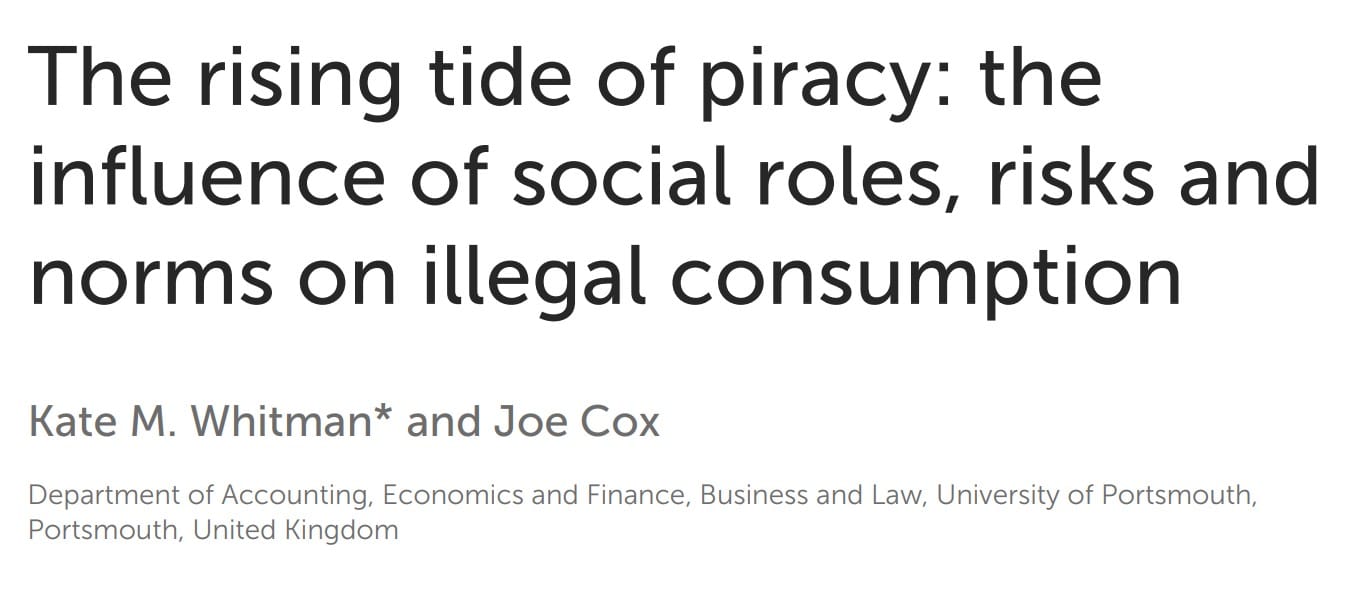 Over the years, we’ve witnessed dozens of anti-piracy campaigns. Despite these efforts, reported piracy rates appear to increase, seemingly undeterred.
Over the years, we’ve witnessed dozens of anti-piracy campaigns. Despite these efforts, reported piracy rates appear to increase, seemingly undeterred.
Research has indicated that piracy is a complex phenomenon that’s not always easy to grasp. However, understanding the motivations of pirates can be key to changing their behavior, new research suggests.
Piracy Study: Social Risks & Norms
An academic study recently published in Frontiers in Behavioral Economics, explores the social drivers of digital piracy, focusing on gender differences. The research, conducted by Kate M. Whitman and Joe Cox, looked at how perceptions of social norms and risks can impact people’s intention to pirate.

The researchers tackled the issue from two different angles, using an online survey of 684 participants.
First, they looked for a link between participants’ personal feelings and their past piracy consumption. They then checked if this was linked to people’s perceived “social risk,” including concerns that pirating would make them look cheap or unethical.
For the second angle, the researchers tested if they could change people’s minds about their future behavior. The respondents had to guess how common piracy is, and some of them were then shown the real piracy rate, taken from a large UK government survey.
This setup effectively created two experimental groups. One was explicitly told that their estimate of the piracy rate among their peers was “too high”, while the others were informed that theirs was “too low”. Finally, a control group received no comparison message at all.
Men Pirate More
The results of the study confirm the existing perceptions on gender differences. Men use pirate sources more often when they consume music or live sports, which are the two content categories addressed in the research.
In the music category, the rate was 3% for women versus 7% for men. The gender gap was even more pronounced for live sports, where men say that 21% of their consumption comes from pirate sources, compared to 8% for women.
“These results show that even when controlling for legal demand, men tend to pirate more than women. They also show that live sport consumers derive more of their consumption from illegal sources than music consumers,” the researchers conclude.
“Social Risk” & The Fear of Looking “Cheap”
The study also examined the link between perceived social risk and piracy. This was measured by asking to what degree friends and family would think the respondent was “unethical,” a “criminal,” or “couldn’t afford legal content” if they knew they pirated.
The perceived social risk score was not correlated with music piracy for men and women. Whether they pirated a lot or barely at all was not linked to these social drawbacks.
For live sports piracy, however, higher perceived social risk was associated with a lower piracy rate, particularly among men. While this is a correlational finding, the researchers suggest that it may be due to male sports culture.
“This aligns with masculine norms that emphasize status, independence, and financial competence, especially within male-dominated, group-oriented social contexts like sports fandom.
“In these settings, the reputational cost of appearing “cheap” or socially deviant may be particularly salient,” the researchers add.

Experiment: Piracy Statistics Can Backfire
The second part of the study was an experiment. It examined whether explicitly pointing out that people over- or underestimate the piracy statistics of their peers, would change their intention to pirate in the future. This led to some key results.
Those who overestimated the official Government data, thinking that piracy was more common among their peers, did not change their future piracy plans. That was true for both men and women.
Intriguingly, however, men who had underestimated how common piracy was increased their willingness to pirate in the future after they were informed that piracy is more prevalent than they thought. On women, this had little effect.
This means that campaigns, studies, and other reports that highlight how widespread piracy is, can actually backfire. Some men may see this as a justification to pirate more themselves.
“These findings highlight the risks of campaigns that emphasize how common piracy is, particularly among men, without considering how such information may inadvertently normalize and license the behavior,” the researchers write.
Limitations and Future Research
While these findings are new and noteworthy, this type of research, which relies on self-reported intentions and behavior, always comes with caveats. The authors of the paper realize this and mention it as one of the limitations.
For example, the social risk questions were asked before participants reported their past piracy behavior. This may have primed participants, influencing their own piracy score.
While not directly mentioned in the paper, the experimental part of the study could also be impacted. By putting participants in a “social risk” mindset, it may have influenced how they estimated peer piracy rates, systematically affecting who was placed in the “underestimator” and “overestimator” groups.
All in all, the study presents a clear takeaway for anti-piracy organizations. For decades, campaigns have focused on highlighting the massive scale of the piracy problem, but this research suggests that revealing how common piracy is could actually backfire.
—
Whitman KM and Cox J (2025) The rising tide of piracy: the influence of social roles, risks and norms on illegal consumption. Front. Behav. Econ. 4:1631329. doi: 10.3389/frbhe.2025.1631329
From: TF, for the latest news on copyright battles, piracy and more.
Powered by WPeMatico
